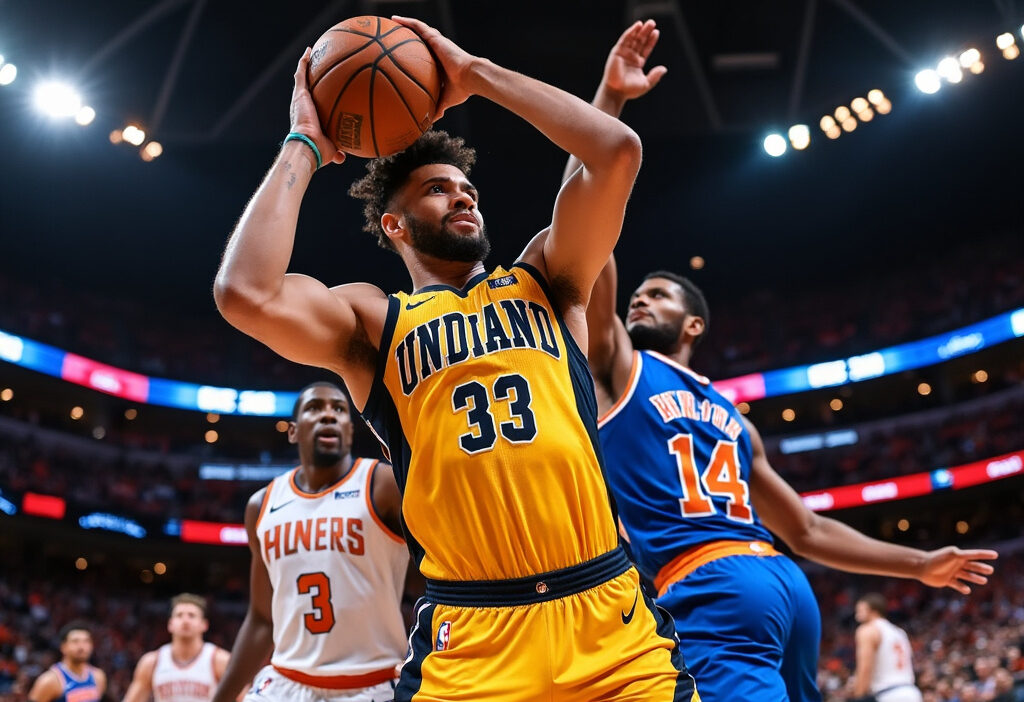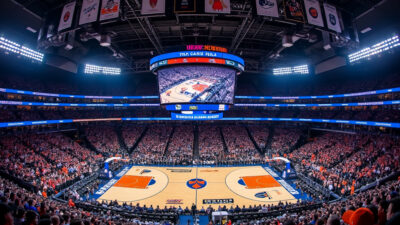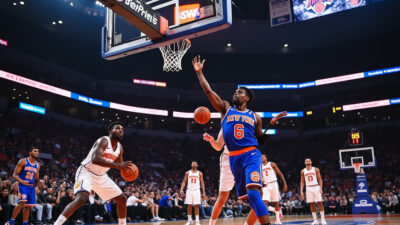Clash at the Garden: Pacers vs. Knicks Showdown Recap and Highlights
On May 21, 2025, the basketball world turned its eyes to Madison Square Garden for Game 1 of the Eastern Conference playoffs, featuring a nail-biting clash between the Indiana Pacers and the New York Knicks. This game promised high stakes, thrilling plays, and a test of resilience, delivering a spectacle that exceeded expectations.
Prelude to the Playoff
Madison Square Garden, often referred to as the Mecca of Basketball, has witnessed countless historic moments, and the opening game of the Eastern Conference playoffs between the Indiana Pacers and New York Knicks was poised to add another chapter to its storied legacy. The Garden’s electrifying atmosphere, amplified by a sea of orange and blue, set the stage for a high-stakes showdown. For the Knicks, playing at home meant leveraging the energy of their passionate fanbase, while the Pacers aimed to silence the crowd and steal early momentum in the series.
The NBA playoffs’ single-elimination intensity was palpable, with both teams understanding the weight of Game 1. A strong start could set the tone for the entire series, while a misstep might force adjustments under pressure. The Knicks, buoyed by their regular-season success, sought to establish dominance early, relying on their physical defense and transition offense. Meanwhile, the Pacers, known for their fast-paced, high-scoring style, looked to exploit the Knicks’ defensive gaps with their dynamic backcourt and relentless ball movement.
This matchup wasn’t just about advancing—it was a test of identity. The Knicks, with their gritty, old-school approach, contrasted sharply with the Pacers’ modern, perimeter-oriented game. The Garden’s hallowed floors had seen legends rise to the occasion, and as tip-off approached, the question loomed: which team would seize control and dictate the narrative of this playoff series? The answer would unfold in the First Quarter Frenzy, where every possession would carry the weight of history.
First Quarter Frenzy
The opening quarter of the Pacers-Knicks showdown at Madison Square Garden was a blistering display of playoff intensity, setting the tone for what would become a fiercely contested battle. From the tip-off, both teams came out with relentless energy, trading baskets in a fast-paced offensive flurry that had the crowd on their feet. The Knicks, feeding off the deafening roar of their home fans, leaned heavily on Jalen Brunson, who orchestrated the offense with precision, slicing through the Pacers’ defense for early buckets. Meanwhile, Indiana countered with a balanced attack, leveraging Tyrese Haliburton’s playmaking to find open looks for Myles Turner and Pascal Siakam beyond the arc.
The Garden’s electric atmosphere amplified every play, with fans erupting as the Knicks’ defensive pressure forced a pair of early turnovers, converting them into transition dunks by Josh Hart. The Pacers, however, refused to buckle, responding with a 10-2 run fueled by Haliburton’s deep threes and Turner’s rim protection.
Strategically, New York prioritized paint dominance, with Isaiah Hartenstein and Mitchell Robinson crashing the boards aggressively, while Indiana spread the floor to exploit the Knicks’ occasional overhelping. The quarter ended with the score tight—a testament to both teams’ refusal to yield an inch. Standout performers included Brunson (12 points) and Haliburton (9 points, 4 assists), whose duel encapsulated the high-stakes nature of the playoffs. The opening 12 minutes were a microcosm of the series’ potential: physical, unpredictable, and utterly captivating.
Defense Takes Center Stage
As the first quarter’s frenetic pace settled, the game transitioned into a defensive chess match, with both the Pacers and Knicks tightening their schemes to disrupt offensive flow. The Knicks, known for their physicality under Tom Thibodeau, ramped up their pressure, employing a mix of switching defenses and aggressive help rotations to clog driving lanes. Myles Turner, the Pacers’ defensive anchor, countered with impeccable timing, recording two crucial blocks in the second quarter—one on Jalen Brunson’s driving layup and another on Julius Randle’s post-up attempt—swatting both shots into the stands to ignite the Indiana bench.
Steals became a defining theme, with Donte DiVincenzo and Tyrese Haliburton trading highlight-reel plays. DiVincenzo’s backcourt steal off an errant Haliburton pass led to a fast-break dunk, while Haliburton responded by picking Josh Hart’s pocket near midcourt, converting it into a transition three. The Pacers’ zone defense momentarily flustered the Knicks, forcing three consecutive turnovers, but New York adjusted by overloading the weak side, exploiting gaps with skip passes to open shooters.
Rebounding battles intensified, particularly on the defensive glass. Isaiah Hartenstein’s box-outs limited Indiana’s second-chance opportunities, while Pascal Siakam’s relentless pursuit kept offensive rebounds alive for the Pacers. The half-court grind favored New York early, but Indiana’s defensive adaptability—switching between drop coverage and aggressive traps—kept the score tight. By halftime, neither team could pull away, a testament to the defensive execution that turned the Garden into a battleground of grit and adjustments.
Offensive Fireworks
The second half of the Pacers-Knicks showdown erupted into an offensive spectacle, as both teams traded blows in a high-scoring duel that electrified Madison Square Garden. After a defensive grind in the middle quarters, the floodgates opened in the third, with Tyrese Haliburton igniting the Pacers’ attack. His back-to-back step-back threes over Jalen Brunson shifted momentum, forcing the Knicks to scramble defensively. The Pacers’ ball movement became surgical, with Obi Toppin capitalizing on mismatches—his thunderous dunk off a Haliburton alley-oop sent shockwaves through the arena.
New York responded with a flurry of their own, as Karl-Anthony Towns took over in the post, bullying smaller defenders with a series of turnaround jumpers and putbacks. His and-one finish through contact late in the third quarter tied the game, setting the stage for a back-and-forth fourth. The Knicks’ perimeter shooting came alive, with Donte DiVincenzo draining two clutch corner threes off Towns’ kick-outs, while the Pacers countered with Haliburton’s crafty floaters and Andrew Nembhard’s timely drives.
The game’s defining sequence came with under three minutes left: Haliburton threaded a no-look pass to Toppin for a transition three, only for Brunson to answer with a deep pull-up on the next possession. The offensive execution was relentless, with neither team able to sustain a decisive run. By the final buzzer, the combined second-half shooting percentages soared above 55%, a stark contrast to the defensive slugfest earlier. This offensive explosion set the tone for the individual heroics that would follow, as the stars took center stage in the closing moments.
Stars of the Show
The Indiana Pacers and New York Knicks showcased their brightest stars in a high-stakes battle at Madison Square Garden, with several players stepping up to deliver unforgettable performances. For the Pacers, Tyrese Haliburton orchestrated the offense with surgical precision, finishing with a near triple-double of 22 points, 12 assists, and 8 rebounds. His ability to control the tempo and exploit defensive mismatches kept the Knicks on their heels, particularly in transition where his vision and unselfish play led to multiple highlight-reel passes.
Obi Toppin, facing his former team, played with a chip on his shoulder, erupting for 18 points off the bench, including several momentum-swinging dunks that energized the Pacers’ second unit. His athleticism and floor-spacing ability stretched the Knicks’ defense, creating driving lanes for his teammates.
On the Knicks’ side, Karl-Anthony Towns was a dominant force in the paint, bullying his way to 26 points and 11 rebounds. His mid-range shooting and post-up game kept the Pacers’ defense guessing, while his physicality forced Indiana into early foul trouble. Towns’ ability to draw double-teams also opened up opportunities for his teammates, though the Knicks struggled to capitalize consistently.
The duel between these stars defined the game’s intensity, with Haliburton’s playmaking, Toppin’s explosiveness, and Towns’ scoring prowess keeping the contest tightly contested. Their performances not only highlighted individual brilliance but also underscored the strategic adjustments both teams made to contain them—a theme that will carry into the next chapter’s breakdown of pivotal moments.
Turning Points
The game between the Pacers and Knicks was a rollercoaster of momentum swings, with several pivotal moments altering the course of the contest. One of the earliest turning points came late in the second quarter when Tyrese Haliburton drained a deep three-pointer just before the halftime buzzer, cutting the Knicks’ lead to single digits. This shot not only energized the Pacers but also shifted the psychological edge, as the Knicks’ defense—which had been stifling—suddenly looked vulnerable.
Another critical juncture arrived in the third quarter when Karl-Anthony Towns picked up his fourth foul, forcing him to the bench. With their star big man sidelined, the Knicks’ interior defense weakened, allowing Obi Toppin to exploit mismatches and score eight quick points in the paint. The Pacers capitalized on this stretch, erasing a 12-point deficit and tying the game.
The fourth quarter saw a controversial call that further tilted the scales. With just under five minutes left, a questionable offensive foul on Jalen Brunson nullified a potential and-one opportunity for the Knicks. Instead of extending their lead, the turnover led to a fast-break dunk by Haliburton, giving the Pacers their first lead since the opening quarter.
Strategic adjustments also played a role. The Pacers’ decision to switch to a small-ball lineup in the final minutes disrupted the Knicks’ rhythm, as their guards struggled to contain Haliburton’s penetration. Meanwhile, the Knicks’ reluctance to double-team him in isolation proved costly, as he repeatedly found open shooters or scored himself. These moments collectively set the stage for the dramatic finish that would follow.
The Final Countdown
The final minutes of the Pacers-Knicks showdown were a masterclass in clutch execution and nerve-wracking tension. With just under three minutes left, the Knicks held a 92-88 lead, seemingly in control after a series of defensive stops. But the Pacers, led by Tyrese Haliburton, had other plans. Haliburton drained a step-back three over Jalen Brunson to cut the deficit to one, igniting a spark in the Indiana bench.
The Knicks responded with a Brunson drive, but Myles Turner swatted the attempt into the stands, shifting momentum entirely. On the ensuing possession, Pascal Siakam bullied his way into the paint for a tie-breaking layup, putting the Pacers up 93-92. The Garden fell silent as the Knicks rushed back, but a costly turnover by Josh Hart—forced by Andrew Nembhard’s relentless pressure—gave Indiana the ball with 45 seconds left.
Haliburton, cool under pressure, orchestrated a flawless pick-and-roll with Turner, drawing two defenders before dishing to Obi Toppin for a corner three that sealed the game at 96-92. The Knicks’ last-ditch efforts—a rushed Brunson three and a missed Randle putback—fell short, cementing the Pacers’ comeback.
Key plays in the final stretch:
- Haliburton’s three at 2:52, cutting the lead to one.
- Turner’s block on Brunson, a defensive game-changer.
- Siakam’s go-ahead layup, showcasing his veteran poise.
- Toppin’s dagger three, a poetic exclamation point against his former team.
The Pacers’ composure in crunch time contrasted sharply with the Knicks’ uncharacteristic miscues, setting the stage for a raucous Garden reaction—or lack thereof—in the moments that followed.
Crowd Reaction
Madison Square Garden was electric as the game reached its climax, the roar of the crowd swelling with every possession. The Knicks faithful, draped in blue and orange, erupted with deafening cheers as Jalen Brunson sank a clutch three-pointer to tie the game late in the fourth quarter. The energy was palpable, the floor vibrating under the stomping feet of fans who had waited years for a playoff moment like this. Every defensive stop was met with thunderous applause, and every missed Pacers shot felt like a collective exhale from the crowd.
But as the Pacers mounted their comeback, the atmosphere shifted. The once-raucous Garden grew tense, the air thick with anxiety. When Tyrese Haliburton drained a step-back three to put Indiana ahead, a stunned silence fell over the arena, broken only by the scattered cheers of Pacers fans who had infiltrated the sea of Knicks supporters. The home crowd tried to rally, chanting “Defense! Defense!” with desperate urgency, but the momentum had swung.
The final seconds were a rollercoaster—gasps as Myles Turner blocked a potential game-tying layup, groans as the Knicks’ last-second heave clanked off the rim. When the buzzer sounded, the Pacers celebrated on the court while the Garden crowd stood in disbelief, their hopes dashed in heartbreaking fashion. The home-court advantage, so dominant earlier, had crumbled under the weight of Indiana’s resilience. Yet, even in defeat, the passion of the Knicks’ faithful was undeniable—a reminder of why MSG is called The World’s Most Famous Arena. Their energy will undoubtedly fuel New York’s fire as the series continues.
Game 1 Analysis
The opening game of the Eastern Conference semifinals between the Indiana Pacers and New York Knicks was a masterclass in contrasting strategies, with both teams leveraging their strengths in a tightly contested battle. The Pacers’ high-octane offense, led by Tyrese Haliburton’s playmaking, exploited the Knicks’ defensive gaps with relentless ball movement and three-point shooting. Indiana shot 42% from beyond the arc, a critical factor in their victory, while also dominating fast-break points (18-6). The Knicks, meanwhile, relied heavily on Jalen Brunson’s isolation scoring and Julius Randle’s physicality in the paint, but their lack of secondary playmakers became glaring as the game progressed.
Defensively, the Pacers disrupted New York’s rhythm by switching aggressively on screens, forcing Brunson into tough mid-range shots. Myles Turner’s rim protection (3 blocks) stifled the Knicks’ interior game, while Obi Toppin’s energy off the bench provided a spark that kept Indiana’s momentum alive. On the other side, the Knicks’ defense struggled to contain Haliburton’s pick-and-roll execution, often leaving shooters open on the weak side.
Key statistics underscored the narrative: Indiana’s assist-to-turnover ratio (24-10) highlighted their disciplined ball control, while New York’s 36% shooting in the fourth quarter revealed their fatigue in closing out possessions. The Pacers’ depth outscored the Knicks’ bench 46-24, a disparity that could haunt New York if unaddressed.
This game suggests a series where pace and versatility may trump star-heavy isolation play. If the Knicks fail to adjust their defensive rotations and find consistent secondary scoring, Indiana’s balanced attack could dictate the tempo moving forward. The Pacers’ ability to sustain their offensive efficiency while limiting turnovers sets a daunting precedent for the rest of the series.
Looking Ahead
The Pacers’ Game 1 victory at Madison Square Garden has set the tone for what promises to be a fiercely contested series. For Indiana, the win validates their aggressive, up-tempo style, which exploited the Knicks’ defensive lapses in transition. However, maintaining this momentum will require adjustments, as New York is unlikely to repeat the same mistakes. The Pacers must anticipate tighter perimeter defense and find alternative ways to generate offense if their three-point shooting cools off. Tyrese Haliburton’s playmaking and Myles Turner’s rim protection will be pivotal, but secondary scorers like Pascal Siakam must step up to diversify the attack.
For the Knicks, the loss exposes vulnerabilities in their half-court execution, particularly when Jalen Brunson faces double-teams. Tom Thibodeau’s squad will likely prioritize ball movement to counter Indiana’s swarming defense, while also tightening their transition defense to limit easy buckets. Julius Randle’s consistency—or lack thereof—remains a wild card; if he can dominate the mid-range and exploit mismatches, it could shift the series. Additionally, the Knicks’ bench, which underwhelmed in Game 1, must provide energy and scoring to relieve pressure on Brunson.
Key adjustments to watch:
- Pacers’ defensive schemes: Will they continue to trap Brunson or switch to a drop coverage to protect the paint?
- Knicks’ offensive rebounding: New York’s second-chance points kept them afloat—can they sustain this against Indiana’s athletic frontcourt?
- Role players: Both teams need contributions beyond their stars; Donte DiVincenzo for the Knicks and Andrew Nembhard for the Pacers could be X-factors.
Game 1 was a statement, but the series will hinge on adaptability. The team that counters adjustments faster will gain the upper hand in this chess match.
Conclusions
The Pacers showcased resilience and strategic execution in snatching a comeback win against the Knicks at the iconic Madison Square Garden, marking an electric start to the Eastern Conference playoffs. This game underscored the importance of key moments and standout performances in the postseason. As the series progresses, the Knicks will look to rebound, ensuring this battle remains closely watched by fans and analysts alike.



